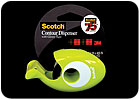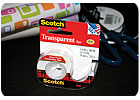3M's Richard Drew Inducted into National Inventors Hall of Fame
Richard Drew, 3M’s legendary inventor of masking and clear cellophane tapes, was posthumously inducted into the National Inventors Hall of Fame in Akron, OH, on May 4, 2007.

Richard Drew, 3M’s legendary inventor of masking and clear cellophane tapes, was posthumously inducted into the National Inventors Hall of Fame in Akron, OH, on May 4.
Drew was hired by 3M as a lab technician in 1921, when the company was mainly a sandpaper manufacturer. He overcame myriad problems by experimenting with a variety of substances until he succeeded in 1925, creating a masking-tape adhesive for automobile painting that could be safely removed without damaging the surface it covered. In 1928, he invented the first transparent tape - the precursor to an entire family of Scotch brand tapes.
Those events marked the beginning of 3M’s long history of innovation in adhesive and bonding technology, including the creation of an almost infinite variety of products for industrial, medical, and construction uses, as well as home and office applications. Today, that adhesive technology has spawned a line of super-strong adhesives ranging from 3M VHB (Very High Bond) tape to release adhesives.
“Richard Drew embodied the essential spirit of the inventor, a person of vision and unrelenting persistence who refused to give in to adversity,” said Dr. Larry Wendling, staff vice president, 3M Corporate Research Laboratories. “He made an enormous contribution, not only to the growth of 3M, but also to advancement of many modern industries vital to worldwide economic growth. We’re delighted to see his work recognized for future generations at the Hall of Fame.”
Drew, who retired in 1962 and died in 1980, created and launched several signature 3M products. Perhaps the biggest part of his legacy was his approach to new-product development, which defines the standard for 3M Innovation: “Connect a 3M technology to a customer need in a creative fashion.”
Throughout his career, Drew tried to create an environment where people were encouraged to follow their instincts. He was known at 3M as a consummate mentor, encouraging and helping to train many of the company’s young scientists, who went on to develop successful products of their own, paving the way for 3M’s culture of innovation.
In 1943, Drew established and became director of the Products Fabrication Laboratory (a precursor to 3M’s Corporate Research Laboratory), where an uninhibited, constructive approach was the philosophy behind research. Out of the lab’s ingenuity came numerous product breakthroughs, including reflective sheeting that helps enhance the visibility of traffic signs and apparel, breathable surgical tapes, foam tapes, electrical insulations, face masks, and respirators. The lab also experimented with adhesives that led to the development of Post-It Notes almost four decades later.
In its 20 years, Drew’s lab created technologies that account for as much as 20% of 3M’s sales today, with products that span all six of the company’s businesses: Consumer and Office; Display and Graphics; Electro and Communications; Health Care; Industrial and Transportation; and Safety, Security and Protection Services. Since the inception of Drew’s lab in 1943, 3M sales have grown from $47 million to more than $22 billion today.
Drew is the third 3M inventor inducted into the National Inventors Hall of Fame this decade. In 2001, chemists Patsy Sherman and the late Samuel Smith were co-inductees for their development of Scotchgard Protector, a product for stain protection and repellency. They jointly hold 13 patents in fluoromaterials polymers and polymerization processes.
Drew is listed as inventor or co-inventor on more than 30 U.S. patents. Today, 3M markets more than 900 pressure-sensitive tapes. The worldwide market for pressure-sensitive tapes and labels is projected to reach nearly $97 billion this year.
Founded in 1973 by the National Council of Intellectual Property Law Associations and the United States Patent and Trademark Office, the National Inventors Hall of Fame honors the work of inductees at its museum in Akron. Inductees are chosen by a national panel of experts in science and technology.
For more information, visit www.3M.com.
Scotch, Post-it, Scotchgard, Thinsulate, Scotch-Brite, Filtrete, Command and Vikuiti are trademarks of 3M.

1930-Drew invents the first waterproof, see-through, pressure-sensitive tape, thus providing an attractive, moisture-proof way to seal cellophane food wrap for bakers, grocers, and meat packers.
Drew sends a trial shipment of the new Scotch cellulose tape to a Chicago firm specializing in printing cellophane for bakery products. The response: “Put this product on the market!” Shortly thereafter, heat-sealing for cellophane virtually eliminates the original use of the new tape. However, Americans in a depressed economy discover they can use the tape to mend a variety of things, like torn pages of books and documents, broken toys, ripped window shades, and even dilapidated currency.
1932-John A. Borden, a 3M sales manager, designs the first heavy-duty tape dispenser with a built-in cutter blade, making it easier to use the tape. The tape can be unwound, cut off and applied in seconds, keeping the end of the tape free and available for the next application.
1945-More than 10 different types of Scotch brand tape are developed to meet wartime requirements. After World War II, 3M resumes shipments of Scotch pressure-sensitive transparent tape for civilian use. The familiar red, green and yellow plaid design is adopted to replace the original blue and white packages.
1961-3M engineers perfect matte finish Scotch brand Magicä transparent tape, which appears frosty on the roll but invisible on the page, and never yellows or oozes adhesives.
1995-Hundreds of Scotch brand tapes flood the market, including double-stick tape, mailing tape, strapping tape, packaging tape, masking tape, colored plastic tape, freezer tape, rug and carpet tape, and reflective tape.
1996-3M introduces Scotch Pop-up Tape Strip Dispensers, which are so innovative they are covered by patents. Pre-cut two-inch tape strips and one-handed pop-up dispensing add speed and convenience to holiday gift wrapping, as well as craft, office, and school projects.
1999-3M introduces Scotch Pop-up Magic Tape Strips and tape strip dispensers for the office market. The top of the dispenser can be removed, enabling the user to wear the cartridge on his or her hand.
Pop-up tape in colorful, disposable dispensers is also introduced for children. More than 900 Scotch tape products are available today.
2000-The Scotch brand celebrates its 75th anniversary.

Photo credit: drumcpherson.com
Richard Drew, 3M’s legendary inventor of masking and clear cellophane tapes, was posthumously inducted into the National Inventors Hall of Fame in Akron, OH, on May 4.
Drew was hired by 3M as a lab technician in 1921, when the company was mainly a sandpaper manufacturer. He overcame myriad problems by experimenting with a variety of substances until he succeeded in 1925, creating a masking-tape adhesive for automobile painting that could be safely removed without damaging the surface it covered. In 1928, he invented the first transparent tape - the precursor to an entire family of Scotch brand tapes.
Those events marked the beginning of 3M’s long history of innovation in adhesive and bonding technology, including the creation of an almost infinite variety of products for industrial, medical, and construction uses, as well as home and office applications. Today, that adhesive technology has spawned a line of super-strong adhesives ranging from 3M VHB (Very High Bond) tape to release adhesives.
“Richard Drew embodied the essential spirit of the inventor, a person of vision and unrelenting persistence who refused to give in to adversity,” said Dr. Larry Wendling, staff vice president, 3M Corporate Research Laboratories. “He made an enormous contribution, not only to the growth of 3M, but also to advancement of many modern industries vital to worldwide economic growth. We’re delighted to see his work recognized for future generations at the Hall of Fame.”
Drew, who retired in 1962 and died in 1980, created and launched several signature 3M products. Perhaps the biggest part of his legacy was his approach to new-product development, which defines the standard for 3M Innovation: “Connect a 3M technology to a customer need in a creative fashion.”
Throughout his career, Drew tried to create an environment where people were encouraged to follow their instincts. He was known at 3M as a consummate mentor, encouraging and helping to train many of the company’s young scientists, who went on to develop successful products of their own, paving the way for 3M’s culture of innovation.
In 1943, Drew established and became director of the Products Fabrication Laboratory (a precursor to 3M’s Corporate Research Laboratory), where an uninhibited, constructive approach was the philosophy behind research. Out of the lab’s ingenuity came numerous product breakthroughs, including reflective sheeting that helps enhance the visibility of traffic signs and apparel, breathable surgical tapes, foam tapes, electrical insulations, face masks, and respirators. The lab also experimented with adhesives that led to the development of Post-It Notes almost four decades later.
In its 20 years, Drew’s lab created technologies that account for as much as 20% of 3M’s sales today, with products that span all six of the company’s businesses: Consumer and Office; Display and Graphics; Electro and Communications; Health Care; Industrial and Transportation; and Safety, Security and Protection Services. Since the inception of Drew’s lab in 1943, 3M sales have grown from $47 million to more than $22 billion today.
Drew is the third 3M inventor inducted into the National Inventors Hall of Fame this decade. In 2001, chemists Patsy Sherman and the late Samuel Smith were co-inductees for their development of Scotchgard Protector, a product for stain protection and repellency. They jointly hold 13 patents in fluoromaterials polymers and polymerization processes.
Drew is listed as inventor or co-inventor on more than 30 U.S. patents. Today, 3M markets more than 900 pressure-sensitive tapes. The worldwide market for pressure-sensitive tapes and labels is projected to reach nearly $97 billion this year.
Founded in 1973 by the National Council of Intellectual Property Law Associations and the United States Patent and Trademark Office, the National Inventors Hall of Fame honors the work of inductees at its museum in Akron. Inductees are chosen by a national panel of experts in science and technology.
About 3M
Every day, 3M people find new ways to make amazing things happen. 3M’s brands include Scotch, Post-it, Scotchgard, Thinsulate, Scotch-Brite, Filtrete, Command and Vikuiti. Serving customers around the world, the people of 3M use their expertise, technologies and global strength to lead in major markets, including consumer and office; display and graphics; electronics and telecommunications; safety, security and protection services; health care; industrial; and transportation.For more information, visit www.3M.com.
Scotch, Post-it, Scotchgard, Thinsulate, Scotch-Brite, Filtrete, Command and Vikuiti are trademarks of 3M.

Photo credit: drumcpherson.com
SIDEBAR: Scotch® Transparent Tape Milestones
1925-Richard Drew, a young 3M engineer, invents Scotch® Masking Tape to help automotive painters achieve a clean, sharp edge where colors meet on two-toned cars.1930-Drew invents the first waterproof, see-through, pressure-sensitive tape, thus providing an attractive, moisture-proof way to seal cellophane food wrap for bakers, grocers, and meat packers.
Drew sends a trial shipment of the new Scotch cellulose tape to a Chicago firm specializing in printing cellophane for bakery products. The response: “Put this product on the market!” Shortly thereafter, heat-sealing for cellophane virtually eliminates the original use of the new tape. However, Americans in a depressed economy discover they can use the tape to mend a variety of things, like torn pages of books and documents, broken toys, ripped window shades, and even dilapidated currency.
1932-John A. Borden, a 3M sales manager, designs the first heavy-duty tape dispenser with a built-in cutter blade, making it easier to use the tape. The tape can be unwound, cut off and applied in seconds, keeping the end of the tape free and available for the next application.
1945-More than 10 different types of Scotch brand tape are developed to meet wartime requirements. After World War II, 3M resumes shipments of Scotch pressure-sensitive transparent tape for civilian use. The familiar red, green and yellow plaid design is adopted to replace the original blue and white packages.
1961-3M engineers perfect matte finish Scotch brand Magicä transparent tape, which appears frosty on the roll but invisible on the page, and never yellows or oozes adhesives.
1995-Hundreds of Scotch brand tapes flood the market, including double-stick tape, mailing tape, strapping tape, packaging tape, masking tape, colored plastic tape, freezer tape, rug and carpet tape, and reflective tape.
1996-3M introduces Scotch Pop-up Tape Strip Dispensers, which are so innovative they are covered by patents. Pre-cut two-inch tape strips and one-handed pop-up dispensing add speed and convenience to holiday gift wrapping, as well as craft, office, and school projects.
1999-3M introduces Scotch Pop-up Magic Tape Strips and tape strip dispensers for the office market. The top of the dispenser can be removed, enabling the user to wear the cartridge on his or her hand.
Pop-up tape in colorful, disposable dispensers is also introduced for children. More than 900 Scotch tape products are available today.
2000-The Scotch brand celebrates its 75th anniversary.
Links
Looking for a reprint of this article?
From high-res PDFs to custom plaques, order your copy today!




-780x439.webp?height=200&t=1762987360&width=200)